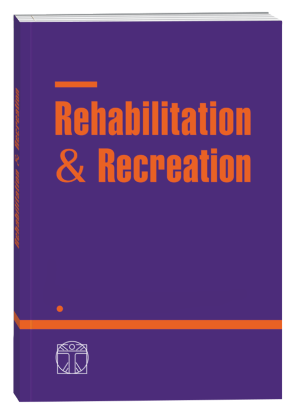HYPODYNAMY AS ONE OF THE CURRENT CAUSES OF THE DEVELOPMENT OF CERVICAL OSTEOCHONDROSIS
DOI:
https://doi.org/10.32782/2522-1795.2022.12.4Keywords:
hypodynamia, cervical osteochondrosis, people of working age, prevention, motor activityAbstract
The article provides a theoretical overview of modern views on the role of hypodynamia in the development of cervical osteochondrosis. Currently, low physical activity contributes to the development of osteochondrosis, especially affecting people of working age. The purpose of this work was to conduct an analysis of data from the scientific and methodological literature on the relevance of the impact of hypodynamia on the development of cervical osteochondrosis. The main signs of hypodynamia in cervical osteochondrosis are considered. Social and psychological reasons for the development of hypodynamia, possible diseases arising as a result of its appearance are analyzed. Current means of prevention and prevention of hypodynamia, with subsequent development of cervical osteochondrosis, are proposed. To achieve the research objectives, we used the following research methods: theoretical: analysis of literary sources related to the researched problem, systematization of data on research issues, obtained in the process of processing scientific articles, textbooks, manuals, dissertation studies; pedagogical: setting goals and objectives, determining the purpose of the study, presenting the results of the study in relation to the subject. The disease of cervical osteochondrosis of the spine is gaining more and more social significance due to the constant growth of the number of patients. It occupies one of the first places in the structure of diseases with temporary loss of working capacity and disability of the population of Ukraine. This disease is becoming more and more relevant due to the constant increase in the number of patients. Hypodynamia associated with work activities increases the morpho-functional deviations of the spine that are present in a significant number of the population, which progress over the years. Long-term restriction of movement mode by a person, due to the specificity of many modern professions, is one of the main causes of cervical osteochondrosis. This leads to chronic overstrain, fatigue and weakening of the muscles, changes in the value of cervical lordosis. The main indicators of hypodynamia are limitation of the motor activity of the body, insufficiency of movements. Movement is what the body needs for stable work, and it is precisely this that is the key to high performance, good health and good health. The use of the proposed means of prevention and prevention of the occurrence of hypodynamia, with the subsequent development of cervical osteochondrosis, allows you to effectively influence a person’s working capacity, his health and well-being.
References
Балюк О.Л. Гіподинамія – сучасна причина розвитку остеохондрозу. Актуальні проблеми навчання та виховання людей з особливими потребами: тези доповідей. К.: Університет «Україна», 2008. 719 с.
Богдановська Н., Кальонова І. Ефективність комплексного застосування засобів кінезотерапії в реабілітації хворих на остеохондроз хребта. Спортивний вісник Придніпров’я, 2012. № 3. С. 122-125.
Герцен Г.І. Клініка, діагностика та лікування синдромів остеохондрозу шийного відділу хребта. К: Вісник медицини, 2011. № 2, 101 с.
Григус І.М., Мельничук Д.В. Фізична реабілітація осіб похилого віку з остеохондрозом шийного відділу хребта. Реабілітаційні та фізкультурно-рекреаційні аспекти розвитку людини. Rehabilitation & recreation. Рівне, 2018. № 3. С. 7-12.
Григус І.М., Нестерчук Н.Є., Крук І.М., Кособуцький Ю.Ф., Петрук Л.А. (2022). Теоретичне обґрунтування засобів фізичної терапії хворих на остеохондроз поперекового відділу хребта. Art of Medicine. 1(21): 144-148.
Дутчак М. Парадигма оздоровчої рухової активності: теоретичне обґрунтування і практичне застосування. Теорія і методика фізичного виховання і спорту, 2015. № 2. С. 44-52.
Калмикова Ю.С. Оцінка ефективності застосування засобів фізичної реабілітації при шийному остеохондрозі. Фізична реабілітація та рекреаційно-оздоровчі технології, 2016. № 2. С. 29-33.
Луценко О.Л., Габелкова О.Є. Конструювання методики схильності до низької фізичної активності – процедура та результати. Психологія: реальність і перспективи: збірник наукових праць Рівненського державного гуманітарного університету, 2017. № 8. С. 171-175.
Рой І.В., Твардовська С.П., Науменко Н.О. Клініко-рентгенологічна стадійність остеохондрозу хребта та принципи його лікування. Вісник ортопедії, травматології та протезування, 2004. № 2. С. 14-18.
Степанова І.В. Організаційно-методичні засади рекреаційно-оздоровчої рухової активності різних груп населення: навч. посібник. Дніпро: «Інновація», 2016. 194 с.
Тимошенко Б.М., Чередніченко Т.М. Рухові здібності людини і методика їх розвитку. Кам. -Под., 2007. 284 с.
Фролов М. Здоров’я вашого хребта і суглобів. Донецьк: ТОВ «Агентство Мультіпрес», 2007. С. 288-289.
Downloads
Published
How to Cite
Issue
Section
License

This work is licensed under a Creative Commons Attribution-NonCommercial-NoDerivatives 4.0 International License.











